FORD SIERRA 1993 2.G Suspension And Steering User Guide
Manufacturer: FORD, Model Year: 1993, Model line: SIERRA, Model: FORD SIERRA 1993 2.GPages: 20, PDF Size: 0.94 MB
Page 11 of 20
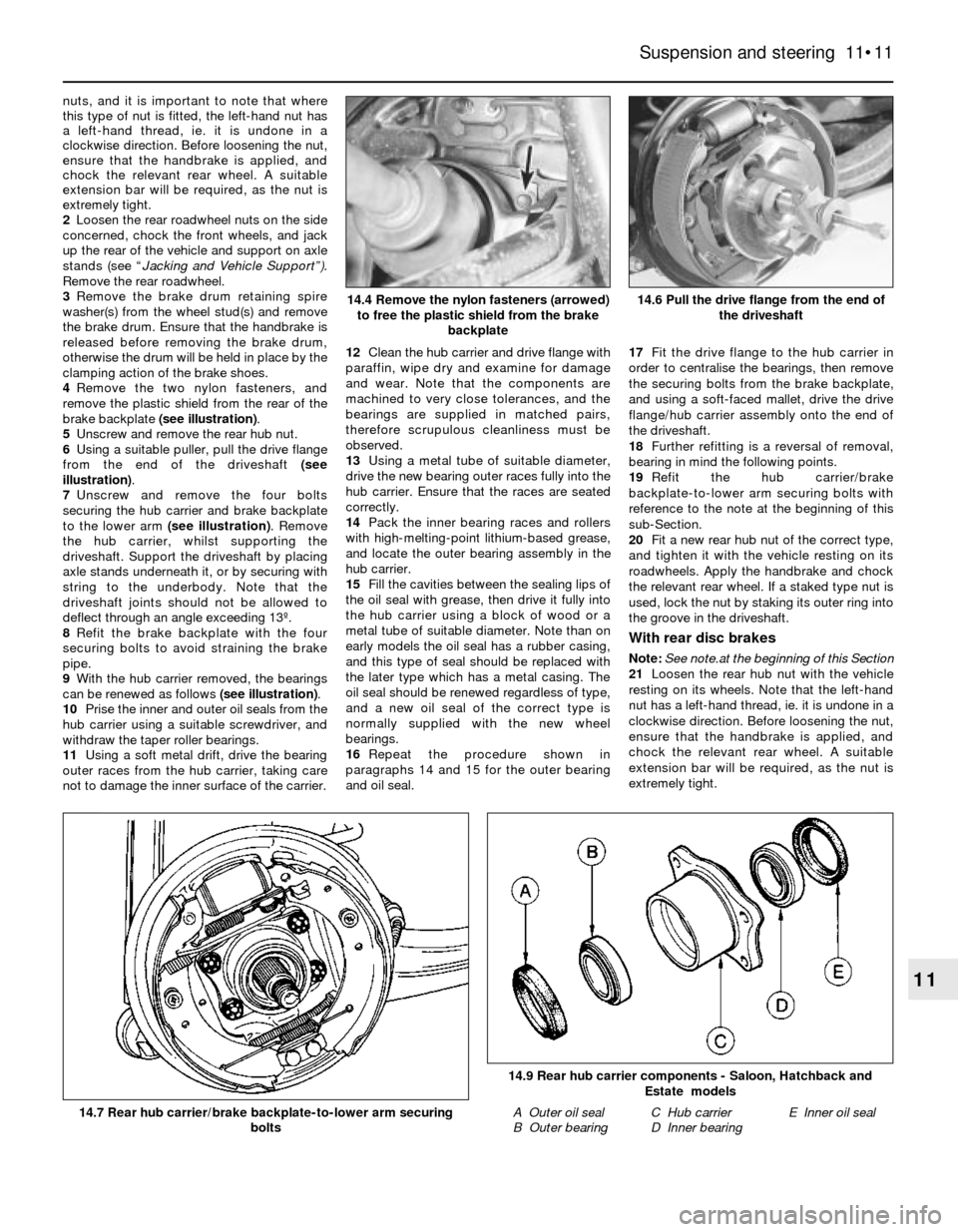
nuts, and it is important to note that where
this type of nut is fitted, the left-hand nut has
a left-hand thread, ie. it is undone in a
clockwise direction. Before loosening the nut,
ensure that the handbrake is applied, and
chock the relevant rear wheel. A suitable
extension bar will be required, as the nut is
extremely tight.
2Loosen the rear roadwheel nuts on the side
concerned, chock the front wheels, and jack
up the rear of the vehicle and support on axle
stands (see “Jacking and Vehicle Support”).
Remove the rear roadwheel.
3Remove the brake drum retaining spire
washer(s) from the wheel stud(s) and remove
the brake drum. Ensure that the handbrake is
released before removing the brake drum,
otherwise the drum will be held in place by the
clamping action of the brake shoes.
4Remove the two nylon fasteners, and
remove the plastic shield from the rear of the
brake backplate (see illustration).
5Unscrew and remove the rear hub nut.
6Using a suitable puller, pull the drive flange
from the end of the driveshaft (see
illustration).
7Unscrew and remove the four bolts
securing the hub carrier and brake backplate
to the lower arm (see illustration). Remove
the hub carrier, whilst supporting the
driveshaft. Support the driveshaft by placing
axle stands underneath it, or by securing with
string to the underbody. Note that the
driveshaft joints should not be allowed to
deflect through an angle exceeding 13º.
8Refit the brake backplate with the four
securing bolts to avoid straining the brake
pipe.
9With the hub carrier removed, the bearings
can be renewed as follows (see illustration).
10Prise the inner and outer oil seals from the
hub carrier using a suitable screwdriver, and
withdraw the taper roller bearings.
11Using a soft metal drift, drive the bearing
outer races from the hub carrier, taking care
not to damage the inner surface of the carrier.12Clean the hub carrier and drive flange with
paraffin, wipe dry and examine for damage
and wear. Note that the components are
machined to very close tolerances, and the
bearings are supplied in matched pairs,
therefore scrupulous cleanliness must be
observed.
13Using a metal tube of suitable diameter,
drive the new bearing outer races fully into the
hub carrier. Ensure that the races are seated
correctly.
14Pack the inner bearing races and rollers
with high-melting-point lithium-based grease,
and locate the outer bearing assembly in the
hub carrier.
15Fill the cavities between the sealing lips of
the oil seal with grease, then drive it fully into
the hub carrier using a block of wood or a
metal tube of suitable diameter. Note than on
early models the oil seal has a rubber casing,
and this type of seal should be replaced with
the later type which has a metal casing. The
oil seal should be renewed regardless of type,
and a new oil seal of the correct type is
normally supplied with the new wheel
bearings.
16Repeat the procedure shown in
paragraphs 14 and 15 for the outer bearing
and oil seal.17Fit the drive flange to the hub carrier in
order to centralise the bearings, then remove
the securing bolts from the brake backplate,
and using a soft-faced mallet, drive the drive
flange/hub carrier assembly onto the end of
the driveshaft.
18Further refitting is a reversal of removal,
bearing in mind the following points.
19Refit the hub carrier/brake
backplate-to-lower arm securing bolts with
reference to the note at the beginning of this
sub-Section.
20Fit a new rear hub nut of the correct type,
and tighten it with the vehicle resting on its
roadwheels. Apply the handbrake and chock
the relevant rear wheel. If a staked type nut is
used, lock the nut by staking its outer ring into
the groove in the driveshaft.
With rear disc brakes
Note: See note.at the beginning of this Section
21Loosen the rear hub nut with the vehicle
resting on its wheels. Note that the left-hand
nut has a left-hand thread, ie. it is undone in a
clockwise direction. Before loosening the nut,
ensure that the handbrake is applied, and
chock the relevant rear wheel. A suitable
extension bar will be required, as the nut is
extremely tight.
Suspension and steering 11•11
11
14.6 Pull the drive flange from the end of
the driveshaft
14.9 Rear hub carrier components - Saloon, Hatchback and
Estate models
A Outer oil seal
B Outer bearingC Hub carrier
D Inner bearingE Inner oil seal14.7 Rear hub carrier/brake backplate-to-lower arm securing
bolts
14.4 Remove the nylon fasteners (arrowed)
to free the plastic shield from the brake
backplate
Page 12 of 20
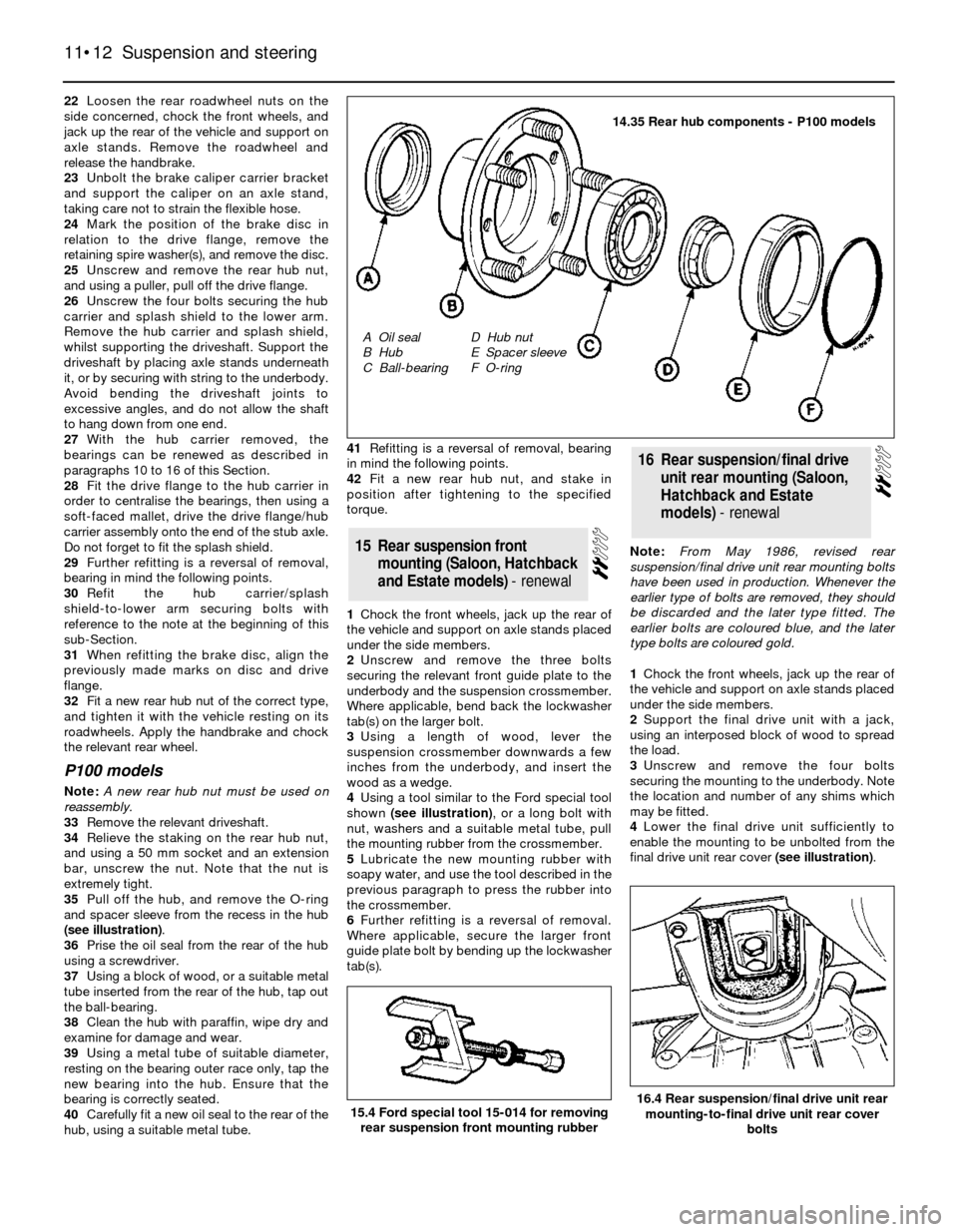
22Loosen the rear roadwheel nuts on the
side concerned, chock the front wheels, and
jack up the rear of the vehicle and support on
axle stands. Remove the roadwheel and
release the handbrake.
23Unbolt the brake caliper carrier bracket
and support the caliper on an axle stand,
taking care not to strain the flexible hose.
24Mark the position of the brake disc in
relation to the drive flange, remove the
retaining spire washer(s), and remove the disc.
25Unscrew and remove the rear hub nut,
and using a puller, pull off the drive flange.
26Unscrew the four bolts securing the hub
carrier and splash shield to the lower arm.
Remove the hub carrier and splash shield,
whilst supporting the driveshaft. Support the
driveshaft by placing axle stands underneath
it, or by securing with string to the underbody.
Avoid bending the driveshaft joints to
excessive angles, and do not allow the shaft
to hang down from one end.
27With the hub carrier removed, the
bearings can be renewed as described in
paragraphs 10 to 16 of this Section.
28Fit the drive flange to the hub carrier in
order to centralise the bearings, then using a
soft-faced mallet, drive the drive flange/hub
carrier assembly onto the end of the stub axle.
Do not forget to fit the splash shield.
29Further refitting is a reversal of removal,
bearing in mind the following points.
30Refit the hub carrier/splash
shield-to-lower arm securing bolts with
reference to the note at the beginning of this
sub-Section.
31When refitting the brake disc, align the
previously made marks on disc and drive
flange.
32Fit a new rear hub nut of the correct type,
and tighten it with the vehicle resting on its
roadwheels. Apply the handbrake and chock
the relevant rear wheel.
P100 models
Note: A new rear hub nut must be used on
reassembly.
33Remove the relevant driveshaft.
34Relieve the staking on the rear hub nut,
and using a 50 mm socket and an extension
bar, unscrew the nut. Note that the nut is
extremely tight.
35Pull off the hub, and remove the O-ring
and spacer sleeve from the recess in the hub
(see illustration).
36Prise the oil seal from the rear of the hub
using a screwdriver.
37Using a block of wood, or a suitable metal
tube inserted from the rear of the hub, tap out
the ball-bearing.
38Clean the hub with paraffin, wipe dry and
examine for damage and wear.
39Using a metal tube of suitable diameter,
resting on the bearing outer race only, tap the
new bearing into the hub. Ensure that the
bearing is correctly seated.
40Carefully fit a new oil seal to the rear of the
hub, using a suitable metal tube.41Refitting is a reversal of removal, bearing
in mind the following points.
42Fit a new rear hub nut, and stake in
position after tightening to the specified
torque.
1Chock the front wheels, jack up the rear of
the vehicle and support on axle stands placed
under the side members.
2Unscrew and remove the three bolts
securing the relevant front guide plate to the
underbody and the suspension crossmember.
Where applicable, bend back the lockwasher
tab(s) on the larger bolt.
3Using a length of wood, lever the
suspension crossmember downwards a few
inches from the underbody, and insert the
wood as a wedge.
4Using a tool similar to the Ford special tool
shown (see illustration), or a long bolt with
nut, washers and a suitable metal tube, pull
the mounting rubber from the crossmember.
5Lubricate the new mounting rubber with
soapy water, and use the tool described in the
previous paragraph to press the rubber into
the crossmember.
6Further refitting is a reversal of removal.
Where applicable, secure the larger front
guide plate bolt by bending up the lockwasher
tab(s).Note: From May 1986, revised rear
suspension/final drive unit rear mounting bolts
have been used in production. Whenever the
earlier type of bolts are removed, they should
be discarded and the later type fitted. The
earlier bolts are coloured blue, and the later
type bolts are coloured gold.
1Chock the front wheels, jack up the rear of
the vehicle and support on axle stands placed
under the side members.
2Support the final drive unit with a jack,
using an interposed block of wood to spread
the load.
3Unscrew and remove the four bolts
securing the mounting to the underbody. Note
the location and number of any shims which
may be fitted.
4Lower the final drive unit sufficiently to
enable the mounting to be unbolted from the
final drive unit rear cover (see illustration).
16Rear suspension/final drive
unit rear mounting (Saloon,
Hatchback and Estate
models) - renewal
15Rear suspension front
mounting (Saloon, Hatchback
and Estate models) - renewal
11•12Suspension and steering
15.4 Ford special tool 15-014 for removing
rear suspension front mounting rubber
14.35 Rear hub components - P100 models
A Oil seal
B Hub
C Ball-bearingD Hub nut
E Spacer sleeve
F O-ring
16.4 Rear suspension/final drive unit rear
mounting-to-final drive unit rear cover
bolts
Page 13 of 20
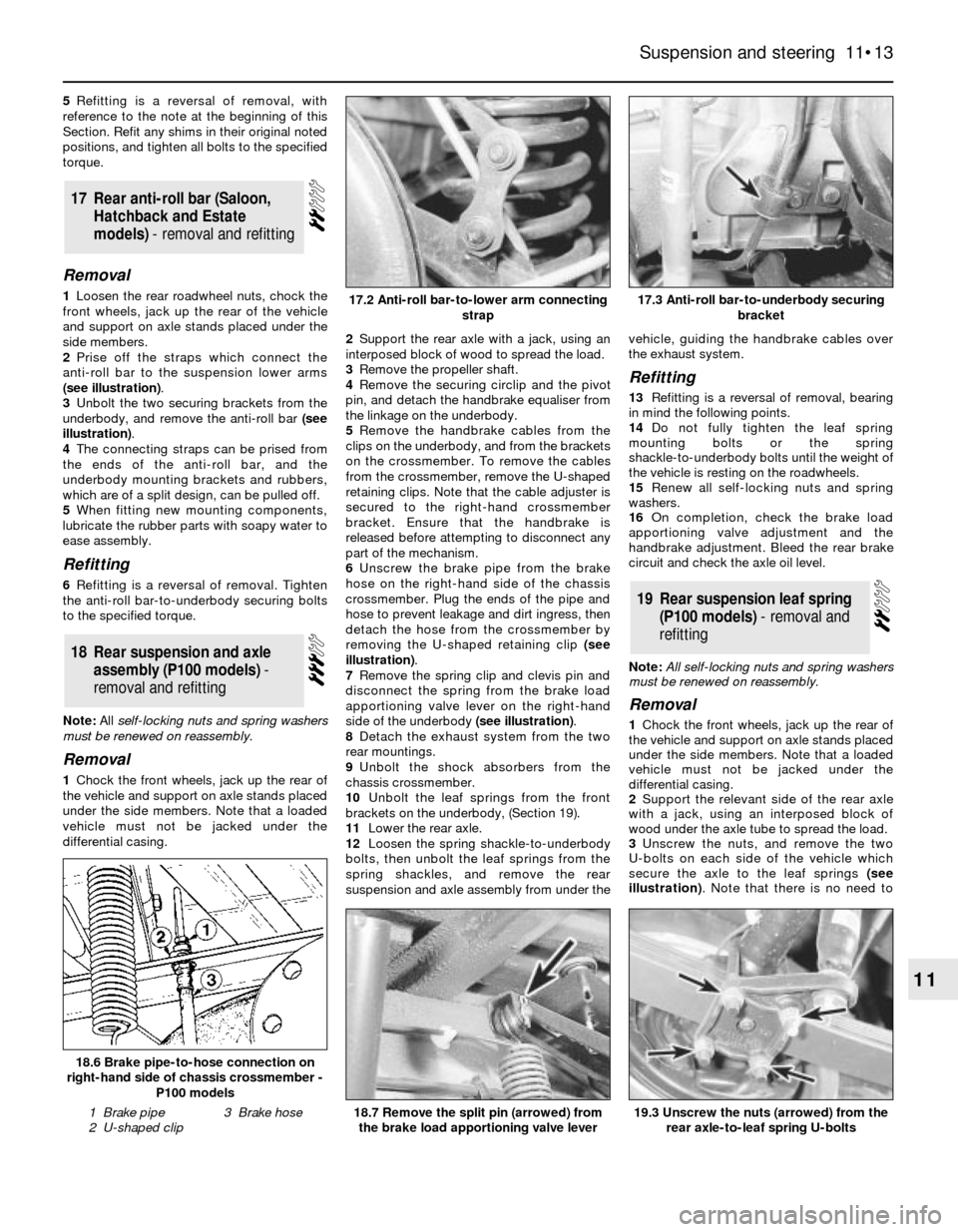
5Refitting is a reversal of removal, with
reference to the note at the beginning of this
Section. Refit any shims in their original noted
positions, and tighten all bolts to the specified
torque.
Removal
1Loosen the rear roadwheel nuts, chock the
front wheels, jack up the rear of the vehicle
and support on axle stands placed under the
side members.
2Prise off the straps which connect the
anti-roll bar to the suspension lower arms
(see illustration).
3Unbolt the two securing brackets from the
underbody, and remove the anti-roll bar (see
illustration).
4The connecting straps can be prised from
the ends of the anti-roll bar, and the
underbody mounting brackets and rubbers,
which are of a split design, can be pulled off.
5When fitting new mounting components,
lubricate the rubber parts with soapy water to
ease assembly.
Refitting
6Refitting is a reversal of removal. Tighten
the anti-roll bar-to-underbody securing bolts
to the specified torque.
Note: All self-locking nuts and spring washers
must be renewed on reassembly.
Removal
1Chock the front wheels, jack up the rear of
the vehicle and support on axle stands placed
under the side members. Note that a loaded
vehicle must not be jacked under the
differential casing.2Support the rear axle with a jack, using an
interposed block of wood to spread the load.
3Remove the propeller shaft.
4Remove the securing circlip and the pivot
pin, and detach the handbrake equaliser from
the linkage on the underbody.
5Remove the handbrake cables from the
clips on the underbody, and from the brackets
on the crossmember. To remove the cables
from the crossmember, remove the U-shaped
retaining clips. Note that the cable adjuster is
secured to the right-hand crossmember
bracket. Ensure that the handbrake is
released before attempting to disconnect any
part of the mechanism.
6Unscrew the brake pipe from the brake
hose on the right-hand side of the chassis
crossmember. Plug the ends of the pipe and
hose to prevent leakage and dirt ingress, then
detach the hose from the crossmember by
removing the U-shaped retaining clip (see
illustration).
7Remove the spring clip and clevis pin and
disconnect the spring from the brake load
apportioning valve lever on the right-hand
side of the underbody (see illustration).
8Detach the exhaust system from the two
rear mountings.
9Unbolt the shock absorbers from the
chassis crossmember.
10Unbolt the leaf springs from the front
brackets on the underbody, (Section 19).
11Lower the rear axle.
12Loosen the spring shackle-to-underbody
bolts, then unbolt the leaf springs from the
spring shackles, and remove the rear
suspension and axle assembly from under thevehicle, guiding the handbrake cables over
the exhaust system.
Refitting
13Refitting is a reversal of removal, bearing
in mind the following points.
14Do not fully tighten the leaf spring
mounting bolts or the spring
shackle-to-underbody bolts until the weight of
the vehicle is resting on the roadwheels.
15Renew all self-locking nuts and spring
washers.
16On completion, check the brake load
apportioning valve adjustment and the
handbrake adjustment. Bleed the rear brake
circuit and check the axle oil level.
Note: All self-locking nuts and spring washers
must be renewed on reassembly.
Removal
1Chock the front wheels, jack up the rear of
the vehicle and support on axle stands placed
under the side members. Note that a loaded
vehicle must not be jacked under the
differential casing.
2Support the relevant side of the rear axle
with a jack, using an interposed block of
wood under the axle tube to spread the load.
3Unscrew the nuts, and remove the two
U-bolts on each side of the vehicle which
secure the axle to the leaf springs (see
illustration). Note that there is no need to
19Rear suspension leaf spring
(P100 models) - removal and
refitting
18Rear suspension and axle
assembly (P100 models) -
removal and refitting
17Rear anti-roll bar (Saloon,
Hatchback and Estate
models) - removal and refitting
Suspension and steering 11•13
11
17.3 Anti-roll bar-to-underbody securing
bracket
18.7 Remove the split pin (arrowed) from
the brake load apportioning valve lever
18.6 Brake pipe-to-hose connection on
right-hand side of chassis crossmember -
P100 models
1 Brake pipe
2 U-shaped clip3 Brake hose
17.2 Anti-roll bar-to-lower arm connecting
strap
19.3 Unscrew the nuts (arrowed) from the
rear axle-to-leaf spring U-bolts
Page 14 of 20
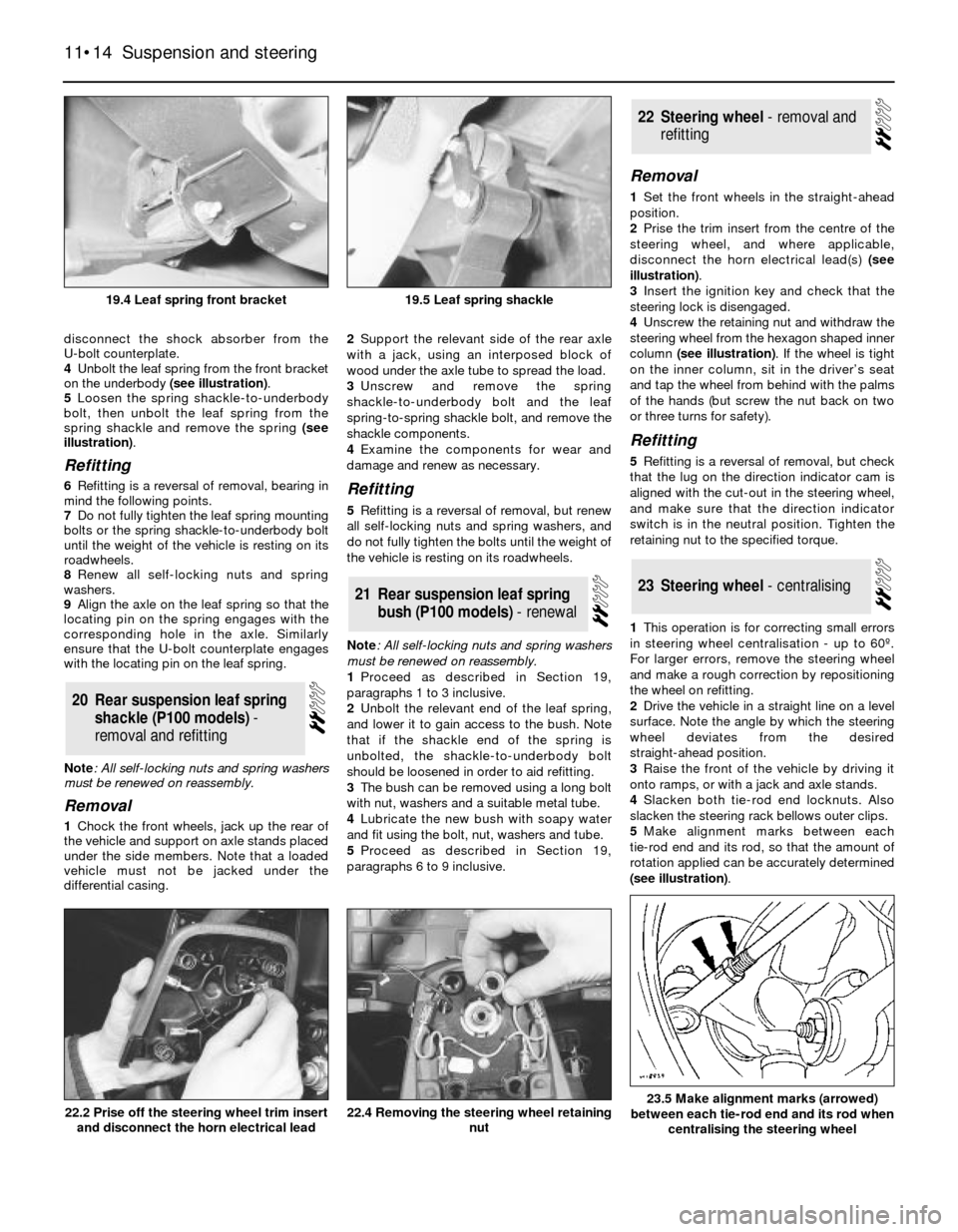
disconnect the shock absorber from the
U-bolt counterplate.
4Unbolt the leaf spring from the front bracket
on the underbody (see illustration).
5Loosen the spring shackle-to-underbody
bolt, then unbolt the leaf spring from the
spring shackle and remove the spring (see
illustration).
Refitting
6Refitting is a reversal of removal, bearing in
mind the following points.
7Do not fully tighten the leaf spring mounting
bolts or the spring shackle-to-underbody bolt
until the weight of the vehicle is resting on its
roadwheels.
8Renew all self-locking nuts and spring
washers.
9Align the axle on the leaf spring so that the
locating pin on the spring engages with the
corresponding hole in the axle. Similarly
ensure that the U-bolt counterplate engages
with the locating pin on the leaf spring.
Note: All self-locking nuts and spring washers
must be renewed on reassembly.
Removal
1Chock the front wheels, jack up the rear of
the vehicle and support on axle stands placed
under the side members. Note that a loaded
vehicle must not be jacked under the
differential casing.2Support the relevant side of the rear axle
with a jack, using an interposed block of
wood under the axle tube to spread the load.
3Unscrew and remove the spring
shackle-to-underbody bolt and the leaf
spring-to-spring shackle bolt, and remove the
shackle components.
4Examine the components for wear and
damage and renew as necessary.
Refitting
5Refitting is a reversal of removal, but renew
all self-locking nuts and spring washers, and
do not fully tighten the bolts until the weight of
the vehicle is resting on its roadwheels.
Note: All self-locking nuts and spring washers
must be renewed on reassembly.
1Proceed as described in Section 19,
paragraphs 1 to 3 inclusive.
2Unbolt the relevant end of the leaf spring,
and lower it to gain access to the bush. Note
that if the shackle end of the spring is
unbolted, the shackle-to-underbody bolt
should be loosened in order to aid refitting.
3The bush can be removed using a long bolt
with nut, washers and a suitable metal tube.
4Lubricate the new bush with soapy water
and fit using the bolt, nut, washers and tube.
5Proceed as described in Section 19,
paragraphs 6 to 9 inclusive.
Removal
1Set the front wheels in the straight-ahead
position.
2Prise the trim insert from the centre of the
steering wheel, and where applicable,
disconnect the horn electrical lead(s) (see
illustration).
3Insert the ignition key and check that the
steering lock is disengaged.
4Unscrew the retaining nut and withdraw the
steering wheel from the hexagon shaped inner
column (see illustration). If the wheel is tight
on the inner column, sit in the driver’s seat
and tap the wheel from behind with the palms
of the hands (but screw the nut back on two
or three turns for safety).
Refitting
5Refitting is a reversal of removal, but check
that the lug on the direction indicator cam is
aligned with the cut-out in the steering wheel,
and make sure that the direction indicator
switch is in the neutral position. Tighten the
retaining nut to the specified torque.
1This operation is for correcting small errors
in steering wheel centralisation - up to 60º.
For larger errors, remove the steering wheel
and make a rough correction by repositioning
the wheel on refitting.
2Drive the vehicle in a straight line on a level
surface. Note the angle by which the steering
wheel deviates from the desired
straight-ahead position.
3Raise the front of the vehicle by driving it
onto ramps, or with a jack and axle stands.
4Slacken both tie-rod end locknuts. Also
slacken the steering rack bellows outer clips.
5Make alignment marks between each
tie-rod end and its rod, so that the amount of
rotation applied can be accurately determined
(see illustration).
23Steering wheel - centralising
22Steering wheel - removal and
refitting
21Rear suspension leaf spring
bush (P100 models) - renewal
20Rear suspension leaf spring
shackle (P100 models) -
removal and refitting
11•14Suspension and steering
19.5 Leaf spring shackle
22.4 Removing the steering wheel retaining
nut22.2 Prise off the steering wheel trim insert
and disconnect the horn electrical lead
19.4 Leaf spring front bracket
23.5 Make alignment marks (arrowed)
between each tie-rod end and its rod when
centralising the steering wheel
Page 15 of 20
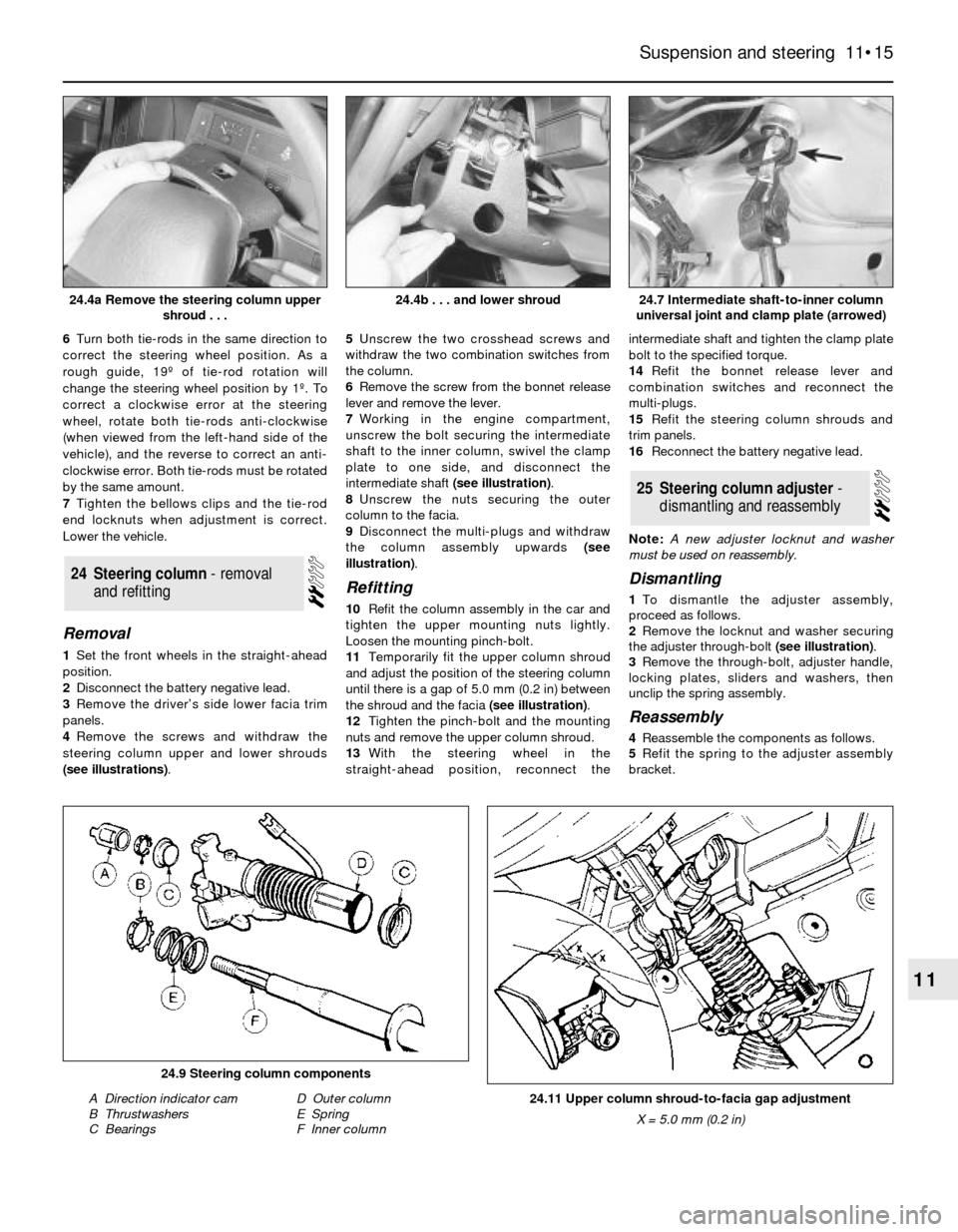
6Turn both tie-rods in the same direction to
correct the steering wheel position. As a
rough guide, 19º of tie-rod rotation will
change the steering wheel position by 1º. To
correct a clockwise error at the steering
wheel, rotate both tie-rods anti-clockwise
(when viewed from the left-hand side of the
vehicle), and the reverse to correct an anti-
clockwise error. Both tie-rods must be rotated
by the same amount.
7Tighten the bellows clips and the tie-rod
end locknuts when adjustment is correct.
Lower the vehicle.
Removal
1Set the front wheels in the straight-ahead
position.
2Disconnect the battery negative lead.
3Remove the driver’s side lower facia trim
panels.
4Remove the screws and withdraw the
steering column upper and lower shrouds
(see illustrations). 5Unscrew the two crosshead screws and
withdraw the two combination switches from
the column.
6Remove the screw from the bonnet release
lever and remove the lever.
7Working in the engine compartment,
unscrew the bolt securing the intermediate
shaft to the inner column, swivel the clamp
plate to one side, and disconnect the
intermediate shaft (see illustration).
8Unscrew the nuts securing the outer
column to the facia.
9Disconnect the multi-plugs and withdraw
the column assembly upwards (see
illustration).
Refitting
10Refit the column assembly in the car and
tighten the upper mounting nuts lightly.
Loosen the mounting pinch-bolt.
11Temporarily fit the upper column shroud
and adjust the position of the steering column
until there is a gap of 5.0 mm (0.2 in) between
the shroud and the facia (see illustration).
12Tighten the pinch-bolt and the mounting
nuts and remove the upper column shroud.
13With the steering wheel in the
straight-ahead position, reconnect theintermediate shaft and tighten the clamp plate
bolt to the specified torque.
14Refit the bonnet release lever and
combination switches and reconnect the
multi-plugs.
15Refit the steering column shrouds and
trim panels.
16Reconnect the battery negative lead.
Note: A new adjuster locknut and washer
must be used on reassembly.
Dismantling
1To dismantle the adjuster assembly,
proceed as follows.
2Remove the locknut and washer securing
the adjuster through-bolt (see illustration).
3Remove the through-bolt, adjuster handle,
locking plates, sliders and washers, then
unclip the spring assembly.
Reassembly
4Reassemble the components as follows.
5Refit the spring to the adjuster assembly
bracket.
25Steering column adjuster -
dismantling and reassembly
24Steering column - removal
and refitting
Suspension and steering 11•15
11
24.4b . . . and lower shroud
24.11 Upper column shroud-to-facia gap adjustment
X = 5.0 mm (0.2 in)
24.9 Steering column components
A Direction indicator cam
B Thrustwashers
C BearingsD Outer column
E Spring
F Inner column
24.7 Intermediate shaft-to-inner column
universal joint and clamp plate (arrowed)24.4a Remove the steering column upper
shroud . . .
Page 16 of 20
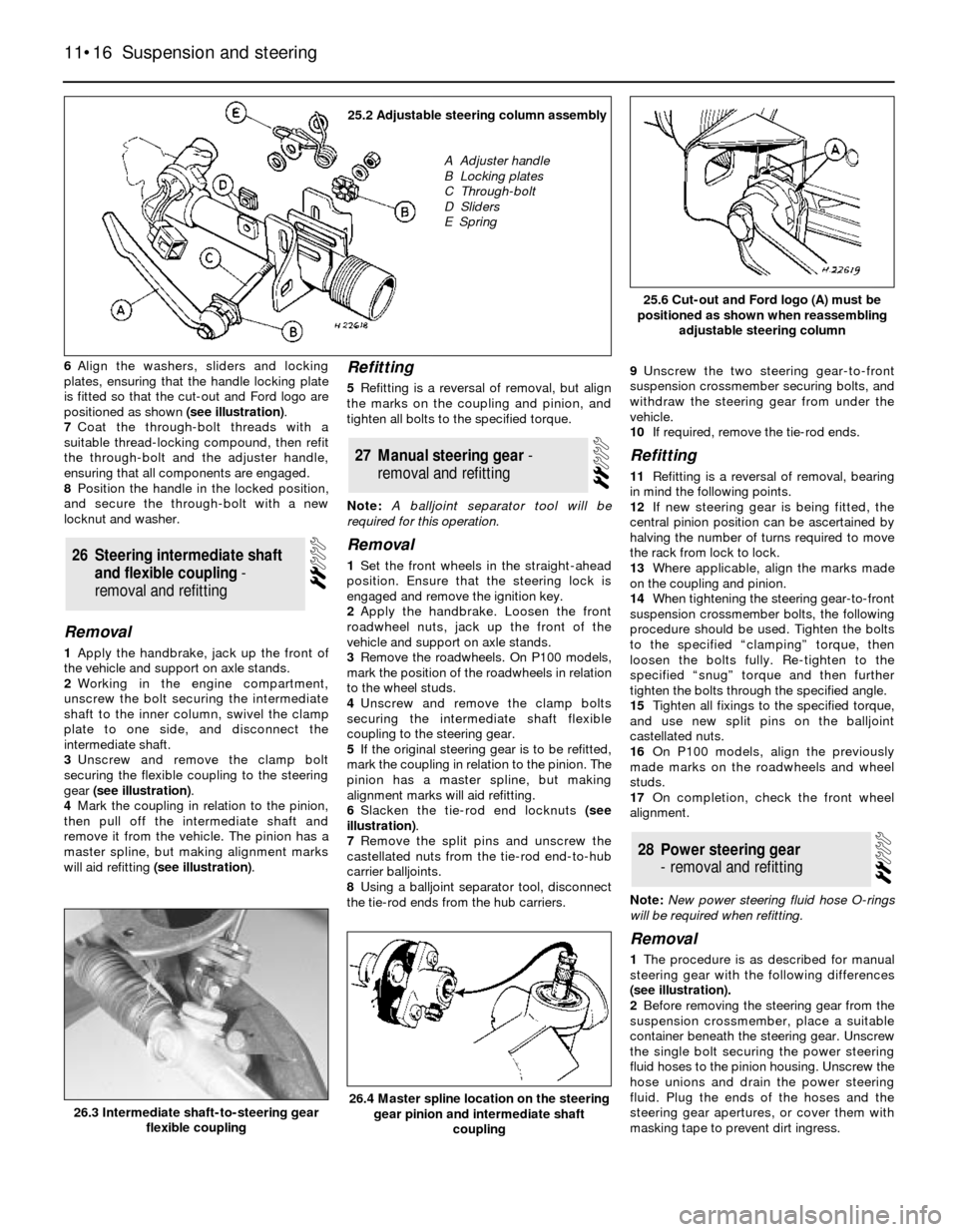
6Align the washers, sliders and locking
plates, ensuring that the handle locking plate
is fitted so that the cut-out and Ford logo are
positioned as shown (see illustration).
7Coat the through-bolt threads with a
suitable thread-locking compound, then refit
the through-bolt and the adjuster handle,
ensuring that all components are engaged.
8Position the handle in the locked position,
and secure the through-bolt with a new
locknut and washer.
Removal
1Apply the handbrake, jack up the front of
the vehicle and support on axle stands.
2Working in the engine compartment,
unscrew the bolt securing the intermediate
shaft to the inner column, swivel the clamp
plate to one side, and disconnect the
intermediate shaft.
3Unscrew and remove the clamp bolt
securing the flexible coupling to the steering
gear (see illustration).
4Mark the coupling in relation to the pinion,
then pull off the intermediate shaft and
remove it from the vehicle. The pinion has a
master spline, but making alignment marks
will aid refitting (see illustration).
Refitting
5Refitting is a reversal of removal, but align
the marks on the coupling and pinion, and
tighten all bolts to the specified torque.
Note: A balljoint separator tool will be
required for this operation.
Removal
1Set the front wheels in the straight-ahead
position. Ensure that the steering lock is
engaged and remove the ignition key.
2Apply the handbrake. Loosen the front
roadwheel nuts, jack up the front of the
vehicle and support on axle stands.
3Remove the roadwheels. On P100 models,
mark the position of the roadwheels in relation
to the wheel studs.
4Unscrew and remove the clamp bolts
securing the intermediate shaft flexible
coupling to the steering gear.
5If the original steering gear is to be refitted,
mark the coupling in relation to the pinion. The
pinion has a master spline, but making
alignment marks will aid refitting.
6Slacken the tie-rod end locknuts (see
illustration).
7Remove the split pins and unscrew the
castellated nuts from the tie-rod end-to-hub
carrier balljoints.
8Using a balljoint separator tool, disconnect
the tie-rod ends from the hub carriers.9Unscrew the two steering gear-to-front
suspension crossmember securing bolts, and
withdraw the steering gear from under the
vehicle.
10If required, remove the tie-rod ends.
Refitting
11Refitting is a reversal of removal, bearing
in mind the following points.
12If new steering gear is being fitted, the
central pinion position can be ascertained by
halving the number of turns required to move
the rack from lock to lock.
13Where applicable, align the marks made
on the coupling and pinion.
14When tightening the steering gear-to-front
suspension crossmember bolts, the following
procedure should be used. Tighten the bolts
to the specified “clamping” torque, then
loosen the bolts fully. Re-tighten to the
specified “snug” torque and then further
tighten the bolts through the specified angle.
15Tighten all fixings to the specified torque,
and use new split pins on the balljoint
castellated nuts.
16On P100 models, align the previously
made marks on the roadwheels and wheel
studs.
17On completion, check the front wheel
alignment.
Note: New power steering fluid hose O-rings
will be required when refitting.
Removal
1The procedure is as described for manual
steering gear with the following differences
(see illustration).
2Before removing the steering gear from the
suspension crossmember, place a suitable
container beneath the steering gear. Unscrew
the single bolt securing the power steering
fluid hoses to the pinion housing. Unscrew the
hose unions and drain the power steering
fluid. Plug the ends of the hoses and the
steering gear apertures, or cover them with
masking tape to prevent dirt ingress.
28Power steering gear
- removal and refitting
27Manual steering gear -
removaland refitting
26Steering intermediate shaft
and flexible coupling -
removal and refitting
11•16Suspension and steering
25.6 Cut-out and Ford logo (A) must be
positioned as shown when reassembling
adjustable steering column
26.4 Master spline location on the steering
gear pinion and intermediate shaft
coupling26.3 Intermediate shaft-to-steering gear
flexible coupling
25.2 Adjustable steering column assembly
A Adjuster handle
B Locking plates
C Through-bolt
D Sliders
E Spring
Page 17 of 20
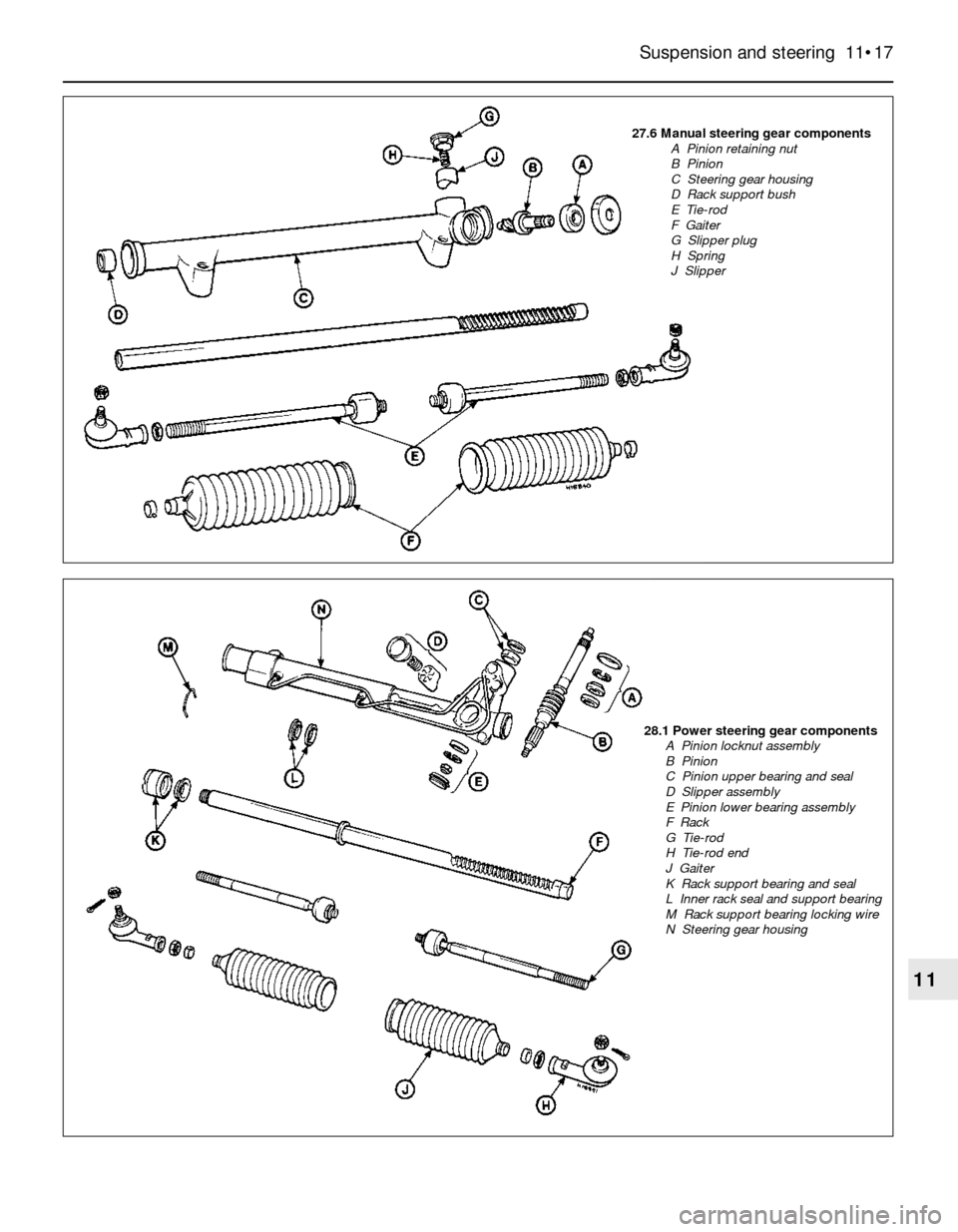
Suspension and steering 11•17
11
27.6 Manual steering gear components
A Pinion retaining nut
B Pinion
C Steering gear housing
D Rack support bush
E Tie-rod
F Gaiter
G Slipper plug
H Spring
J Slipper
28.1 Power steering gear components
A Pinion locknut assembly
B Pinion
C Pinion upper bearing and seal
D Slipper assembly
E Pinion lower bearing assembly
F Rack
G Tie-rod
H Tie-rod end
J Gaiter
K Rack support bearing and seal
L Inner rack seal and support bearing
M Rack support bearing locking wire
N Steering gear housing
Page 18 of 20
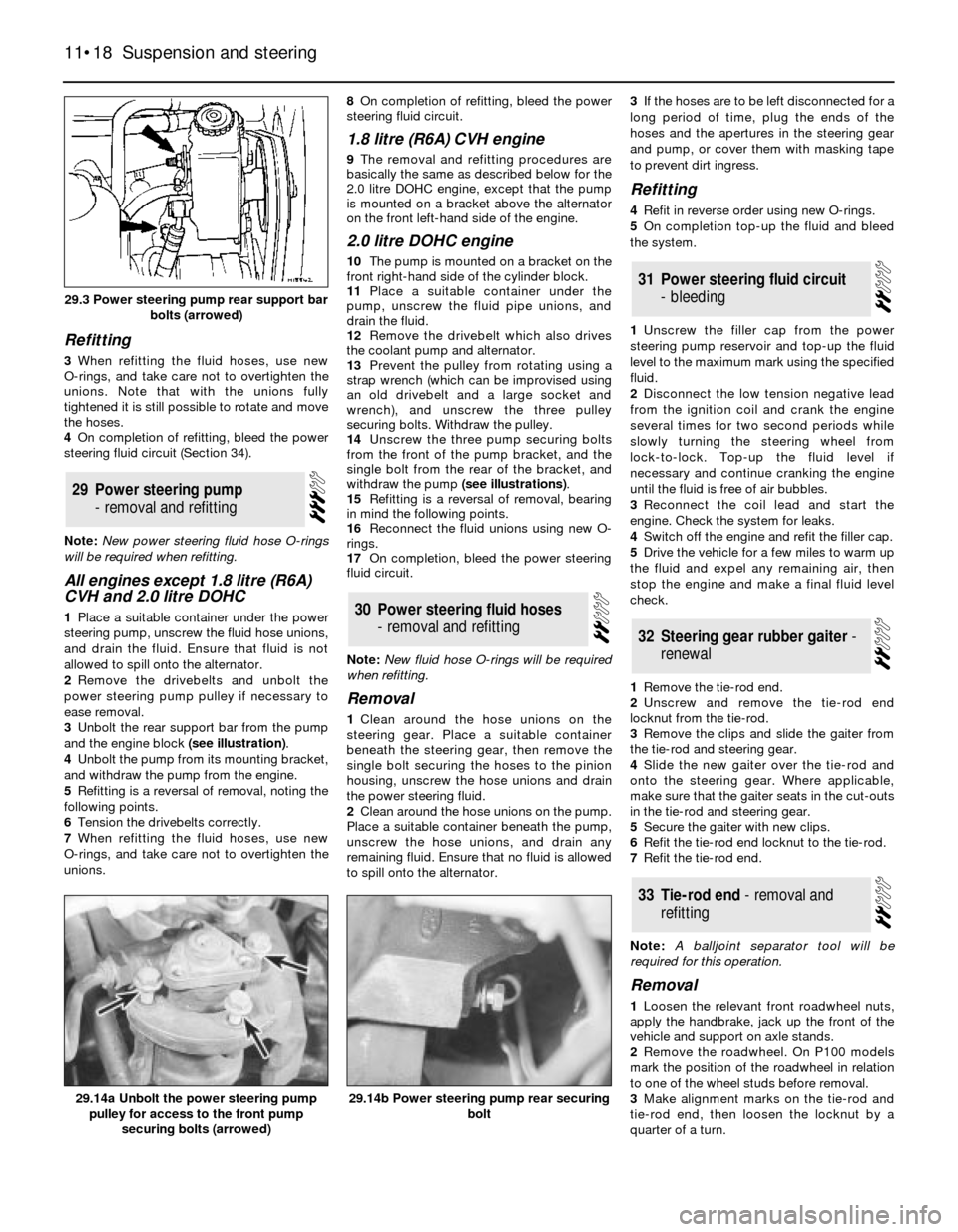
Refitting
3When refitting the fluid hoses, use new
O-rings, and take care not to overtighten the
unions. Note that with the unions fully
tightened it is still possible to rotate and move
the hoses.
4On completion of refitting, bleed the power
steering fluid circuit (Section 34).
Note: New power steering fluid hose O-rings
will be required when refitting.
All engines except 1.8 litre (R6A)
CVH and 2.0 litre DOHC
1Place a suitable container under the power
steering pump, unscrew the fluid hose unions,
and drain the fluid. Ensure that fluid is not
allowed to spill onto the alternator.
2Remove the drivebelts and unbolt the
power steering pump pulley if necessary to
ease removal.
3Unbolt the rear support bar from the pump
and the engine block (see illustration).
4Unbolt the pump from its mounting bracket,
and withdraw the pump from the engine.
5Refitting is a reversal of removal, noting the
following points.
6Tension the drivebelts correctly.
7When refitting the fluid hoses, use new
O-rings, and take care not to overtighten the
unions. 8On completion of refitting, bleed the power
steering fluid circuit.
1.8 litre (R6A) CVH engine
9The removal and refitting procedures are
basically the same as described below for the
2.0 litre DOHC engine, except that the pump
is mounted on a bracket above the alternator
on the front left-hand side of the engine.
2.0 litre DOHC engine
10The pump is mounted on a bracket on the
front right-hand side of the cylinder block.
11Place a suitable container under the
pump, unscrew the fluid pipe unions, and
drain the fluid.
12Remove the drivebelt which also drives
the coolant pump and alternator.
13Prevent the pulley from rotating using a
strap wrench (which can be improvised using
an old drivebelt and a large socket and
wrench), and unscrew the three pulley
securing bolts. Withdraw the pulley.
14Unscrew the three pump securing bolts
from the front of the pump bracket, and the
single bolt from the rear of the bracket, and
withdraw the pump (see illustrations).
15Refitting is a reversal of removal, bearing
in mind the following points.
16Reconnect the fluid unions using new O-
rings.
17On completion, bleed the power steering
fluid circuit.
Note: New fluid hose O-rings will be required
when refitting.
Removal
1Clean around the hose unions on the
steering gear. Place a suitable container
beneath the steering gear, then remove the
single bolt securing the hoses to the pinion
housing, unscrew the hose unions and drain
the power steering fluid.
2Clean around the hose unions on the pump.
Place a suitable container beneath the pump,
unscrew the hose unions, and drain any
remaining fluid. Ensure that no fluid is allowed
to spill onto the alternator.3If the hoses are to be left disconnected for a
long period of time, plug the ends of the
hoses and the apertures in the steering gear
and pump, or cover them with masking tape
to prevent dirt ingress.
Refitting
4Refit in reverse order using new O-rings.
5On completion top-up the fluid and bleed
the system.
1Unscrew the filler cap from the power
steering pump reservoir and top-up the fluid
level to the maximum mark using the specified
fluid.
2Disconnect the low tension negative lead
from the ignition coil and crank the engine
several times for two second periods while
slowly turning the steering wheel from
lock-to-lock. Top-up the fluid level if
necessary and continue cranking the engine
until the fluid is free of air bubbles.
3Reconnect the coil lead and start the
engine. Check the system for leaks.
4Switch off the engine and refit the filler cap.
5Drive the vehicle for a few miles to warm up
the fluid and expel any remaining air, then
stop the engine and make a final fluid level
check.
1Remove the tie-rod end.
2Unscrew and remove the tie-rod end
locknut from the tie-rod.
3Remove the clips and slide the gaiter from
the tie-rod and steering gear.
4Slide the new gaiter over the tie-rod and
onto the steering gear. Where applicable,
make sure that the gaiter seats in the cut-outs
in the tie-rod and steering gear.
5Secure the gaiter with new clips.
6Refit the tie-rod end locknut to the tie-rod.
7Refit the tie-rod end.
Note: A balljoint separator tool will be
required for this operation.
Removal
1Loosen the relevant front roadwheel nuts,
apply the handbrake, jack up the front of the
vehicle and support on axle stands.
2Remove the roadwheel. On P100 models
mark the position of the roadwheel in relation
to one of the wheel studs before removal.
3Make alignment marks on the tie-rod and
tie-rod end, then loosen the locknut by a
quarter of a turn.
33Tie-rod end - removal and
refitting
32Steering gear rubber gaiter -
renewal
31Power steering fluid circuit
- bleeding
30Power steering fluid hoses
- removal and refitting
29Power steering pump
- removal and refitting
11•18Suspension and steering
29.3 Power steering pump rear support bar
bolts (arrowed)
29.14b Power steering pump rear securing
bolt29.14a Unbolt the power steering pump
pulley for access to the front pump
securing bolts (arrowed)
Page 19 of 20
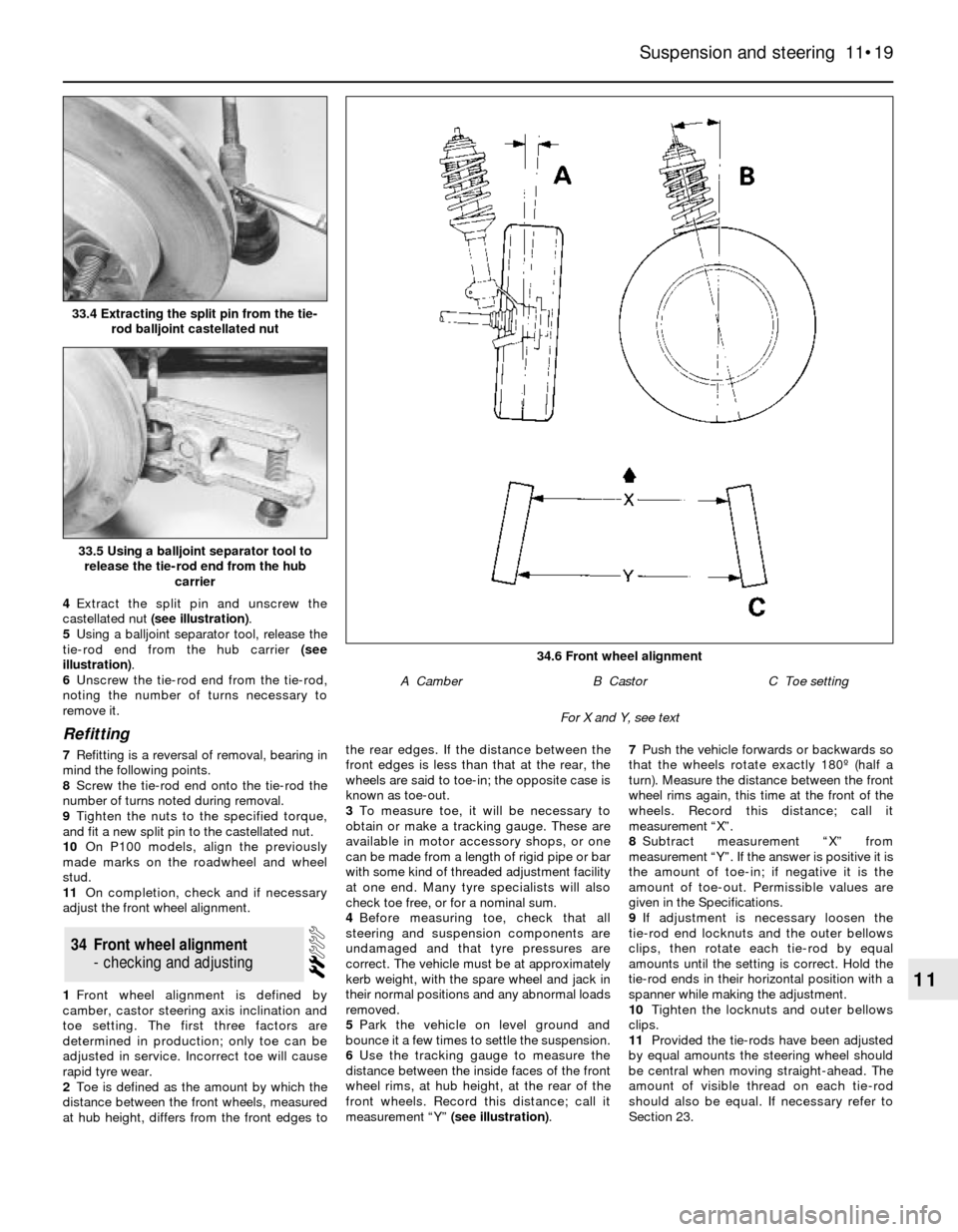
4Extract the split pin and unscrew the
castellated nut (see illustration).
5Using a balljoint separator tool, release the
tie-rod end from the hub carrier (see
illustration).
6Unscrew the tie-rod end from the tie-rod,
noting the number of turns necessary to
remove it.
Refitting
7Refitting is a reversal of removal, bearing in
mind the following points.
8Screw the tie-rod end onto the tie-rod the
number of turns noted during removal.
9Tighten the nuts to the specified torque,
and fit a new split pin to the castellated nut.
10On P100 models, align the previously
made marks on the roadwheel and wheel
stud.
11On completion, check and if necessary
adjust the front wheel alignment.
1Front wheel alignment is defined by
camber, castor steering axis inclination and
toe setting. The first three factors are
determined in production; only toe can be
adjusted in service. Incorrect toe will cause
rapid tyre wear.
2Toe is defined as the amount by which the
distance between the front wheels, measured
at hub height, differs from the front edges tothe rear edges. If the distance between the
front edges is less than that at the rear, the
wheels are said to toe-in; the opposite case is
known as toe-out.
3To measure toe, it will be necessary to
obtain or make a tracking gauge. These are
available in motor accessory shops, or one
can be made from a length of rigid pipe or bar
with some kind of threaded adjustment facility
at one end. Many tyre specialists will also
check toe free, or for a nominal sum.
4Before measuring toe, check that all
steering and suspension components are
undamaged and that tyre pressures are
correct. The vehicle must be at approximately
kerb weight, with the spare wheel and jack in
their normal positions and any abnormal loads
removed.
5Park the vehicle on level ground and
bounce it a few times to settle the suspension.
6Use the tracking gauge to measure the
distance between the inside faces of the front
wheel rims, at hub height, at the rear of the
front wheels. Record this distance; call it
measurement “Y” (see illustration).7Push the vehicle forwards or backwards so
that the wheels rotate exactly 180º (half a
turn). Measure the distance between the front
wheel rims again, this time at the front of the
wheels. Record this distance; call it
measurement “X”.
8Subtract measurement “X” from
measurement “Y”. If the answer is positive it is
the amount of toe-in; if negative it is the
amount of toe-out. Permissible values are
given in the Specifications.
9If adjustment is necessary loosen the
tie-rod end locknuts and the outer bellows
clips, then rotate each tie-rod by equal
amounts until the setting is correct. Hold the
tie-rod ends in their horizontal position with a
spanner while making the adjustment.
10Tighten the locknuts and outer bellows
clips.
11Provided the tie-rods have been adjusted
by equal amounts the steering wheel should
be central when moving straight-ahead. The
amount of visible thread on each tie-rod
should also be equal. If necessary refer to
Section 23.
34Front wheel alignment
- checking and adjusting
Suspension and steering 11•19
11
34.6 Front wheel alignment
A CamberB CastorC Toe setting
For X and Y, see text
33.5 Using a balljoint separator tool to
release the tie-rod end from the hub
carrier
33.4 Extracting the split pin from the tie-
rod balljoint castellated nut
Page 20 of 20

11•20Notes